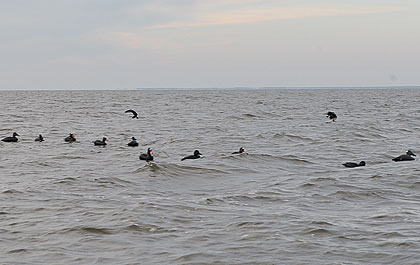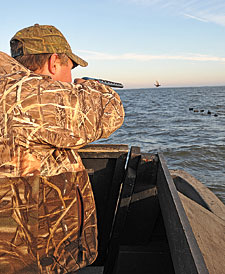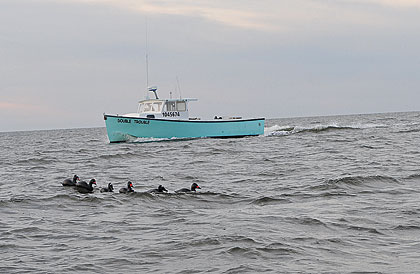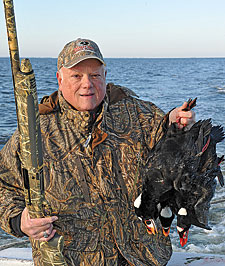January 10, 2011
By John Taylor
Sea ducks prove to be tough targets in North Carolina.
By John M. Taylor
Like inky, undulating streaks of soot, four scoters skimmed the waves in the gray light of dawn. Teddy Gibbs quickly snapped a black flag back and forth and made a short, loud whistle, trying to attract the dusky ducks to our rig. That bunch thumbed their noses at us, but soon, a single coal-black surf scoter took the bait and flew into the rig, wings set. I let loose with a volley and touched not a feather, as the streaks of shot on the water well behind the fast-flying bird attested.
I swore to shoot better in the future.
A Light Chop
Teddy Gibbs, of Jennette's Guide Service in Engelhard, N.C., picked me up at 4:30 a.m. on the dot. We drove for about 20 minutes until we reached the pier where Gibb's 35-foot commercial fishing boat was docked. We were met by Teddy Gibbs' cousin, C.R. Gibbs, who served as first mate on the day's hunt.
Advertisement
"I like to get there early, so I can have my choice of locations," Teddy Gibbs said as he gunned the big diesel and slipped the prop into gear.
Conditions were nearly perfect. Winds were light, yet enough to provide some chop to keep the decoys moving and shuffle the ducks, too. The day promised to be clear and about 50 degrees, which made it a little chilly, but not miserable as sea ducking can be, so a parka and a pair of wader pants kept me warm and cozy.
As we left the anchorage, we picked up the blind, a 14-foot former bass boat with a sturdy wooden blind erected on it. Painted black, the blind allows the hunters to sit comfortably while peering through strategically placed peep slots to watch for approaching ducks. Weighing the impressive anchor and hoisting it aboard, Teddy Gibbs attached the blind to a line, allowing us to tow it to the hunting grounds.
Advertisement
 A 14-foot former bass boat painted black makes a roomy, yet stealthy floating blind. |
Setting a Spread
Teddy Gibbs carries his decoys in crates and barrels, sorted depending on the length of the string. Decoys are rigged on long lines with a single heavy anchor. He uses sections of 6-inch black-plastic drainage pipes filled with concrete with a sturdy eye-bolt embedded in the center for weights at the head of the line, with the decoys then free to trail with the wind.
Having arrived at the selected spot indicated by the GPS, we first dropped and anchored the blind using the outside controls of his boat, which enable handling it when hoisting crab pots or laying and retrieving decoys. The guide put out eight strings of decoys using his boat hook, and then grabbed the line hoisting the anchor aboard to maneuver them into position relative to the blind. Several decoys floated forward of the blind on each side, with the others trailing behind the blind.
Sea ducks like to fly in strings, and also prefer to work the decoys in a parade-ground formation. Although sea ducks may seem to be somewhat naïve compared to pintails or black ducks, they aren't all that stupid.
"People think that hunting sea ducks is easy," Teddy Gibbs said. "But they've become far more wary over the years, and for the most part, hunting them from white boats is gone."
Teddy Gibbs was referring to the long-time tradition of tossing out some decoys, then hunting scoters from large fishing boats. I have hunted sea ducks that way on Chesapeake Bay, but more recently have used layout boats that all but conceal the hunter. Even those using large boats have been forced to use floating blinds to give the ducks sufficient comfort to come close.
 Although sea ducks might seem to be somewhat naïve compared to pintails or black ducks, they aren't all that stupid. |
Three Species
There are three varieties of scoters -- the American black scoter, white-winged scoter and surf scoter -- found on the Atlantic Flyway wintering grounds that run down the East Coast from Maine through Chesapeake Bay, Pamlico Sound in North Carolina and ending at the Georgia-Florida border.
"We sometimes get some white-winged scoters down here, but not often," Teddy Gibbs said. "We pretty much shoot black and surf scoters."
 Gunning for scoters over rocking waves is a formidable challenge. |
The black scoter is just as described, all black, although the females are more of a dusky, dark brown with a gray neck and cheek. The male black scoter's bill has an orange bulge close to the face that ends in the bill's tip being black.
Male surf scoters, on the other hand, have a white patch on the top of their heads and a similar white patch down their face between the eyes. They have a bright orange bill with a large, bulbous protrusion extending from their face to the tip of the bill. The female surf scoter is drab brown, with just a hint of the male's white head patch and a gray breast and belly.
The white-winged scoter resembles the black scoter, except the male has a white eye patch, and the speculum of their wings is white. All scoters eat primarily clams and invertebrates, feeding only occasionally on vegetation, all of which make them a very strong-tasting duck. There are numerous recipes for preparing them that involve considerable soaking and marinating to remove the strong flavor.
 The tender boat moves in quickly to collect fallen scoters. Sea ducks are especially hard to kill, and cripples can vanish into the chop in a hurry. |
Tough To Kill
I don't know if it's the motion of the rocking and rolling blind or what, but sea ducks are difficul
t to both hit and kill. My average on hit ducks to fired shells was abysmally low.
Teddy Gibbs good-naturedly chided my spotty shooting, but he, too, burned up quite a few shells. I asked him about his recommendation for shotguns.
"If you have a 10 gauge, and can shoot it well, you ought to bring it," he emphatically said, as I thought of my 10 gauge languishing at home in the safe. It is my go-to gun for Eastern Shore Canada geese. Hit them once and they drop, and I can easily see what an advantage the 10 would be on scoters.
I can't think of a tougher duck than a sea duck. From the sinkboxes of Lac St. Pierre on the Saint Lawrence Seaway through Chesapeake Bay to the waters of Pamlico Sound, I've never shot tougher ducks. Even when hit hard, they drop to the water and begin to swim.
Good coordination between the tender boat and blind is essential. As soon as we finished shooting, Teddy Gibbs would be on the radio to C.R. Gibbs, directing him to the dead and crippled ducks.
"Two on your side of the decoys," was Teddy Gibbs' typical call when a pickup was needed. Nimbly handling a long-handled dip net, C.R. Gibbs scooped dead and heavily wounded ducks into the big tender. When necessary, he administered the coup de grace from his well-worn shotgun when a cripple tried to escape. Notorious divers, scoters can lead the tender boat on a merry chase.
Limit of Surfs
Because Pamlico Sound is all salt water, special care is necessary for anything metal in that environ-ment. My shotgun is camo-clad, hence much less vulnerable to rust and corrosion.
Had it been rough weather -- Gibbs will not hunt in hazardous conditions -- with a great deal of spray, I would have immediately sought a complete flush with fresh water at dockside, because the only way to combat salt water is to flush it completely from the gun with fresh water.
 By 8:30 a.m., the limit of scoters was met. |
As the day brightened, duck activity slacked, but some flocks traded across the waves. By about 8:30 a.m., we had our eight-duck limit -- all surf scoters.
Picking up is almost as big a dance as rigging out the decoys. Using the outside engine and rudder controls, Teddy Gibbs deftly maneuvered the big boat so he could snag the decoy lines with his boat hook, pull them up and then heave up the anchor, dunk it a few times to clean off the mud and drop it into the barrel, followed by quickly pulling up the line of decoys.
All of his decoys are tied about 6 or 8 feet apart on one heavy main line that carries about 10 or 12 decoys, making putting out and picking up fast.
Should it become necessary to completely change locations, it probably takes a slim 15 minutes to pull the decoy rig, weigh the anchor of the blind, attach it to the tender boat and speed to a new location. Picking up when a limit of birds is riding on the fantail is less harried, but only takes a few moments more.
After lunch in Engelhard, I headed home through the southeastern stretches of rural North Carolina, where cotton is king, then up through the peanut-farming area of Virginia, past Petersburg, where General Lee's army finally crumbled and led the Federals to Appomattox.
Tired and happy, I pulled into my home in northern Virginia, already planning another trip south, perhaps for a swan and more bouncing shooting at wary sea ducks with Teddy Gibbs.
Die-hard waterfowler John Taylor hails from Lorton, Va.
